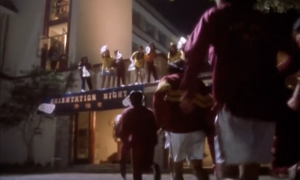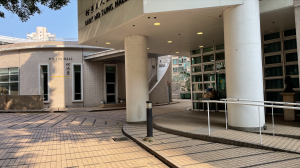CITY OF GLASS, DIR. MABLE CHEUNG (1998)
Lady Ho Tung Hall, Central and Western District, Hong Kong

After the reunion dinner, hallmates are chatting outside the main entrance of Lady Ho Tung Hall
City of Glass was published by Company Golden Harvest in 1998. The reconstruction of Lady Ho Tung Hall is the main reason that Dir. Mabel Cheung decides to film this movie since the old building contains all her memory of college life. The story happens under the background of the 1997 turnover, the time when Hong Kong citizens were feeling uncertain and hazy about their future. The movie mainly narrates a love tragedy of a couple who was once young lovers during their days at the University of Hong Kong. Conflicts and contradictions between present and future, tradition and modernity, and eastern and western are presented everywhere in Hong Kong and the film. Therefore, the reconstruction of Lady Ho Tung Hall is exactly a miniature of Hong Kong, and it also reflects the atmosphere of Hong Kong society at that time.
One day before the reconstruction, a reunion was held inside the Lady Ho Tung Hall for the hallmates to revisit this place that kept their memory. It is an L-shaped four floors building with buffy paint and a lawn outside. The new building’s design model is placed at the entrance, and photos are hung inside the hall to celebrate this special day. The director also utilizes traditional hall functions, like the high table dinner, to present the hall’s specialty. However, it now becomes a 20-floor building with modern design, white paint, and glass outside, which lost its uniqueness. Part of the original place was utilized to build up another hall that has the same design. The lawn remains, but part of them is now covered by ground tile. The images of the original Lady Ho Tung Hall only stay in people’s memory. At the same time, a few features of the hall still contain. In Abbas’s words, the city is changing rapidly, so citizens experience “the unfamiliar in the familiar, that is, the unfamiliar that is half-seen subliminally behind the seen/scene of the familiar.”1
The preservation of old buildings gives us history in site, but it also means keeping history in sight.”2 During the reunion, the only decoration on the table is goblets. All hallmates hold a glass of wine. And you can see them knocking the goblets with forks and hear the sound of them crashing each other. This scene echoes the name of the film “City of Glass.” Also, the glasses symbolize the disappearance of Lady Ho Tung Hall and their fading culture. In the year 1997, everything is fragile, like glass. It can be love, memory, building, family, or even the city of Hong Kong. What’s more, the hall setting is dark and heavy, which implies the uncertainty of the future. The director employed the reconstruction event and then extended it into a larger scale of reflection, showing the Hong Kong history and social atmosphere in a love tragedy.
— Lau Kong Ngai, 3035822756


- Left: Hallmates are observing the design model of the new building. Right: Activity during the Orientation day.


Left: Today’s Lady Ho Tung Hall entrance Right: The original place of the little lawn
Notes:
1 Ackbar Abbas, “Building on Disappearance: Hong Kong Architecture and the City,78
2 Ackbar Abbas, “Building on Disappearance: Hong Kong Architecture and the City, 89
Good attempt to cite Abbas’ text to your point of Lady Ho Tung Hall’s preservation. Your report will greatly benefit if there are more photos accompanied with it. You have detailed descriptions that I would hope to see them visually presented especially the interior shots. I understand that Lady Ho Tung Hall is a female only hall which makes it perhaps difficult to visit. However, the male lead is from Ricci Hall; there might be possible scenes which were shot there that you can visit. If for whatever reason that you could only observe in person but not visually document them, you can make use of secondary-sourced photos from the internet to support your primary observations. It would also be great if there are more movie stills as it is rather difficult for people who have not watched the movie to fully comprehend your arguments. Overall, good effort in analysing the film!
A minor point to note: 1997 is Hong Kong’s handover, not turnover.